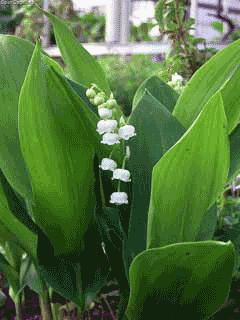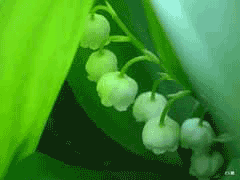 |
|
http://opencage.info/pics/ |
 |
| http://photozou.jp/photo/show/ |
Translate this page:
Summary
Physical Characteristics

 Convallaria keiskei is a PERENNIAL growing to 0.3 m (1ft).
Convallaria keiskei is a PERENNIAL growing to 0.3 m (1ft).
See above for USDA hardiness. It is hardy to UK zone 3 and is not frost tender. It is in flower from April to May. The species is hermaphrodite (has both male and female organs) and is pollinated by Bees, flies. The plant is self-fertile.
Suitable for: light (sandy), medium (loamy) and heavy (clay) soils. Suitable pH: mildly acid, neutral and basic (mildly alkaline) soils. It can grow in full shade (deep woodland) semi-shade (light woodland) or no shade. It prefers dry moist or wet soil.
UK Hardiness Map
US Hardiness Map
Synonyms
C. japonica. C. majalis. non L. C. majalis keiskei. (Miq.)Maxim. C. majalis mandschurica.
Plant Habitats
Woodland Garden Dappled Shade; Shady Edge; Ground Cover; Bog Garden;
Edible Uses
Edible Parts: Flowers Leaves
Edible Uses: Tea
The whole plant is cooked as a potherb or put in miso soup[177, 183]. Caution is advised, see the notes above on toxicity. The flowers and flower buds are preserved in salt or mixed with leaf tea and drunk[177, 183].
References More on Edible Uses
Medicinal Uses
Plants For A Future can not take any responsibility for any adverse effects from the use of plants. Always seek advice from a professional before using a plant medicinally.
None known
References More on Medicinal Uses
The Bookshop: Edible Plant Books
Our Latest books on Perennial Plants For Food Forests and Permaculture Gardens in paperback or digital formats.

Edible Tropical Plants
Food Forest Plants for Hotter Conditions: 250+ Plants For Tropical Food Forests & Permaculture Gardens.
More

Edible Temperate Plants
Plants for Your Food Forest: 500 Plants for Temperate Food Forests & Permaculture Gardens.
More

More Books
PFAF have eight books available in paperback and digital formats. Browse the shop for more information.
Shop Now
Other Uses
Plants can be grown as a ground cover in woodland shade or in a shrubbery[200].
Special Uses
Ground cover
References More on Other Uses
Cultivation details
Succeeds in almost any situation, including the dense dry shade of large trees[1, 24]. Prefers a position in semi-shade in a moderately fertile well-drained moist woodland soil[200]. Grows well in heavy clay soils. Plants are hardy to -20°c or lower[200]. A good bee plant[4]. A very ornamental plant, though it can become very invasive once it is established[200]. Plants seem to be immune to the predations of rabbits[233].
References Carbon Farming Information and Carbon Sequestration Information
Temperature Converter
Type a value in the Celsius field to convert the value to Fahrenheit:
Fahrenheit:
The PFAF Bookshop
Plants For A Future have a number of books available in paperback and digital form. Book titles include Edible Plants, Edible Perennials, Edible Trees,Edible Shrubs, Woodland Gardening, and Temperate Food Forest Plants. Our new book is Food Forest Plants For Hotter Conditions (Tropical and Sub-Tropical).
Shop Now
Plant Propagation
Seed - best sown as soon as it is ripe, otherwise in late winter, in a cold frame[164]. Germination, particularly of stored seed can be very slow, taking 2 - 12 months or more at 15°c[164]. Sow the seed thinly so that the seedlings can be allowed to grow on undisturbed in the pot for their first year. Apply a liquid feed during the growing season to ensure that the seedlings are well fed. Divide the young plants into individual pots when they die down in late summer and grow them on in pots in a shady position in a cold frame for at least another year before planting them out into their permanent positions when they are dormant[K]. Division in September[111]. Very easy, larger clumps can be replanted direct into their permanent positions, though it is best to pot up smaller clumps and grow them on in a cold frame until they are rooting well. Plant them out in the spring.
Other Names
If available other names are mentioned here
Native Range
TEMPERATE ASIA: Russian Federation (Chita, Irkutsk, Krasnoyarsk (south)), Mongolia (east), Russian Federation (Habarovskij kraj, Primorye, Amur, Sakhalin), China (Gansu Sheng, Hebei Sheng, Heilongjiang Sheng, Henan Sheng, Hunan Sheng, Jilin Sheng, Liaoning Sheng, Nei Mongol Zizhiqu, Ningxia Huizi Zizhiqu, Shaanxi Sheng, Shandong Sheng, Shanxi Sheng, Zhejiang Sheng), Korea, Japan (Hokkaidô, Honshu, Kyushu) TROPICAL ASIA: Myanmar (north)
Weed Potential
Right plant wrong place. We are currently updating this section.
Please note that a plant may be invasive in one area but may not in your area so it's worth checking.
Conservation Status
IUCN Red List of Threatened Plants Status :

| Related Plants
|
| Latin Name | Common Name | Habit | Height | Hardiness | Growth | Soil | Shade | Moisture | Edible | Medicinal | Other |
| Aspidistra elatior | Aspidistra, Cast Iron Plant | Perennial | 0.6 |
7-11
| S | LMH | FS | DM | 0 | 2 | 3 |
| Clintonia borealis | Bluebeard | Perennial | 0.3 |
3-7
| | LM | FS | M | 2 | 1 | 2 |
| Clintonia udensis | | Perennial | 0.3 |
3-7
| | LM | FS | M | 2 | 0 | |
| Clintonia umbellulata | Speckled Wood Lily, White clintonia | Perennial | 0.2 |
4-8
| | LM | FS | M | 2 | 0 | |
| Convallaria majalis | Lily Of The Valley, European lily of the valley | Perennial | 0.2 |
2-7
| F | LMH | FSN | DMWe | 1 | 3 | 3 |
| Liriope graminifolia | Lilyturf | Perennial | 0.3 |
7-10
| | LM | SN | DM | 2 | 1 | 2 |
| Liriope minor | | Perennial | 0.3 |
7-10
| | LM | SN | DM | 2 | 1 | 2 |
| Liriope muscari | Lilyturf, Big blue lilyturf, Border Grass, Blue Lilyturf, Liriope | Perennial | 0.3 |
5-10
| S | LM | SN | DM | 2 | 1 | 2 |
| Liriope spicata | Lily Turf, Creeping liriope, Creeping Lilyturf | Perennial | 0.3 |
4-10
| F | LM | SN | DM | 2 | 1 | 2 |
| Maianthemum canadense | Canada Beadruby, Canada mayflower | Perennial | 0.1 |
3-7
| F | LMH | FS | M | 1 | 1 | 2 |
| Maianthemum dilatatum | Wild Lily Of The Valley, False lily of the valley | Perennial | 0.2 |
3-7
| | LMH | FS | M | 2 | 1 | |
| Ophiopogon japonicus | Snake's Beard, Dwarf lilyturf, Mondo Grass, Monkey Grass, Dwarf Lilyturf | Perennial | 0.3 |
7-11
| S | LM | SN | MWeWa | 2 | 3 | 2 |
| Polygonatum biflorum | Small Solomon's Seal | Perennial | 1.0 |
3-7
| | LMH | FS | M | 2 | 1 | 2 |
| Polygonatum cirrhifolium | | Perennial | 1.2 |
-
| | LMH | FS | M | 2 | 2 | |
| Polygonatum commutatum | King Solomon's Seal, Smooth Solomon's seal | Perennial | 2.0 |
4-8
| | LMH | FS | M | 2 | 1 | 1 |
| Polygonatum cyrtonema | | Perennial | 0.0 |
-
| | LMH | FS | M | 0 | 2 | |
| Polygonatum falcatum | | Perennial | 0.6 |
4-8
| | LMH | FS | DM | 2 | 1 | 0 |
| Polygonatum humile | | Perennial | 0.3 |
4-8
| | LMH | FS | M | 2 | 1 | |
| Polygonatum inflatum | | Perennial | 0.6 |
-
| | LMH | FS | M | 2 | 1 | |
| Polygonatum involucratum | | Perennial | 0.3 |
-
| | LMH | FS | M | 2 | 0 | |
| Polygonatum kingianum | | Perennial | 2.0 |
-
| | LMH | FS | M | 0 | 2 | |
| Polygonatum lasianthum | | Perennial | 0.6 |
-
| | LMH | FS | M | 2 | 0 | |
| Polygonatum macropodum | | Perennial | 1.0 |
-
| | LMH | FS | M | 2 | 1 | |
| Polygonatum maximowiczii | | Perennial | 1.0 |
-
| | LMH | FS | M | 2 | 0 | |
| Polygonatum multiflorum | Solomon's Seal, Eurasian Solomon's seal | Perennial | 1.2 |
4-8
| | LMH | FS | DM | 2 | 3 | 3 |
| Polygonatum odoratum | Solomon's Seal | Perennial | 0.9 |
4-8
| M | LMH | FS | DM | 2 | 3 | |
| Polygonatum odoratum thunbergii | | Perennial | 0.5 |
4-8
| | LMH | FS | M | 2 | 0 | |
| Polygonatum pubescens | Hairy Solomon's Seal | Perennial | 1.0 |
3-7
| | LMH | FS | M | 2 | 1 | |
| Polygonatum sibiricum | Huang Jing | Perennial | 1.0 |
3-7
| | LMH | FS | M | 2 | 2 | 1 |
|
|
Growth: S = slow M = medium F = fast. Soil: L = light (sandy) M = medium H = heavy (clay). pH: A = acid N = neutral B = basic (alkaline). Shade: F = full shade S = semi-shade N = no shade. Moisture: D = dry M = Moist We = wet Wa = water.
Now available:
Food Forest Plants for Mediterranean Conditions
350+ Perennial Plants For Mediterranean and Drier Food Forests and Permaculture Gardens.
[Paperback and eBook]
This is the third in Plants For A Future's series of plant guides for food forests tailored to
specific climate zones. Following volumes on temperate and tropical ecosystems, this book focuses
on species suited to Mediterranean conditions—regions with hot, dry summers and cool, wet winters,
often facing the added challenge of climate change.
Read More
Expert comment
Author
Miq.
Botanical References
58200
Links / References
For a list of references used on this page please go here
Readers comment
| Add a comment |
|
If you have important information about this plant that may help other users please add a comment or link below. Only comments or links that are felt to be directly relevant to a plant will be included. If you think a comment/link or information contained on this page is inaccurate or misleading we would welcome your feedback at [email protected]. If you have questions about a plant please use the Forum on this website as we do not have the resources to answer questions ourselves.
* Please note: the comments by website users are not necessarily those held by PFAF and may give misleading or inaccurate information.
To leave a comment please Register or login here All comments need to be approved so will not appear immediately.
|
Subject : Convallaria keiskei
|
|
|
|